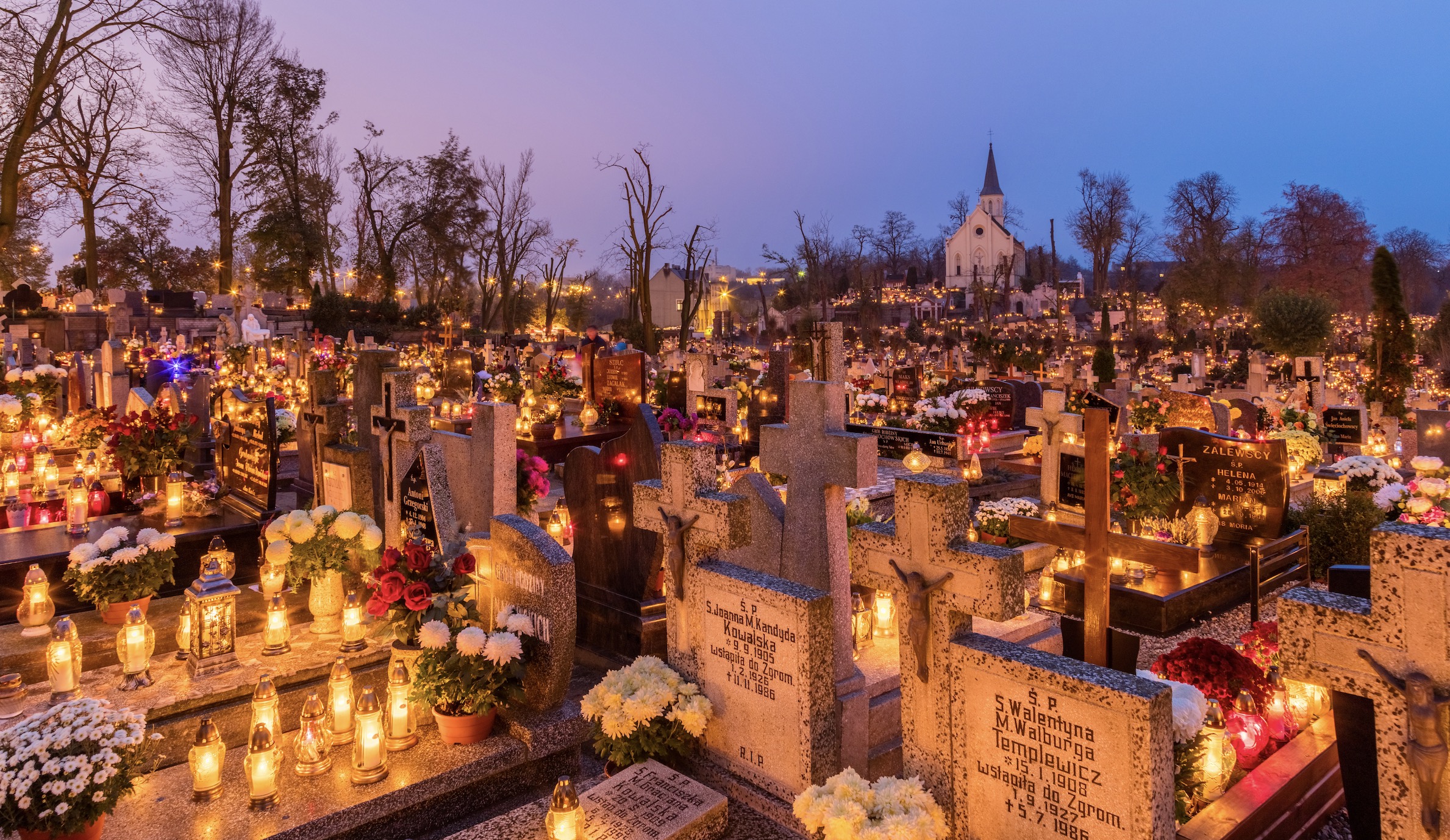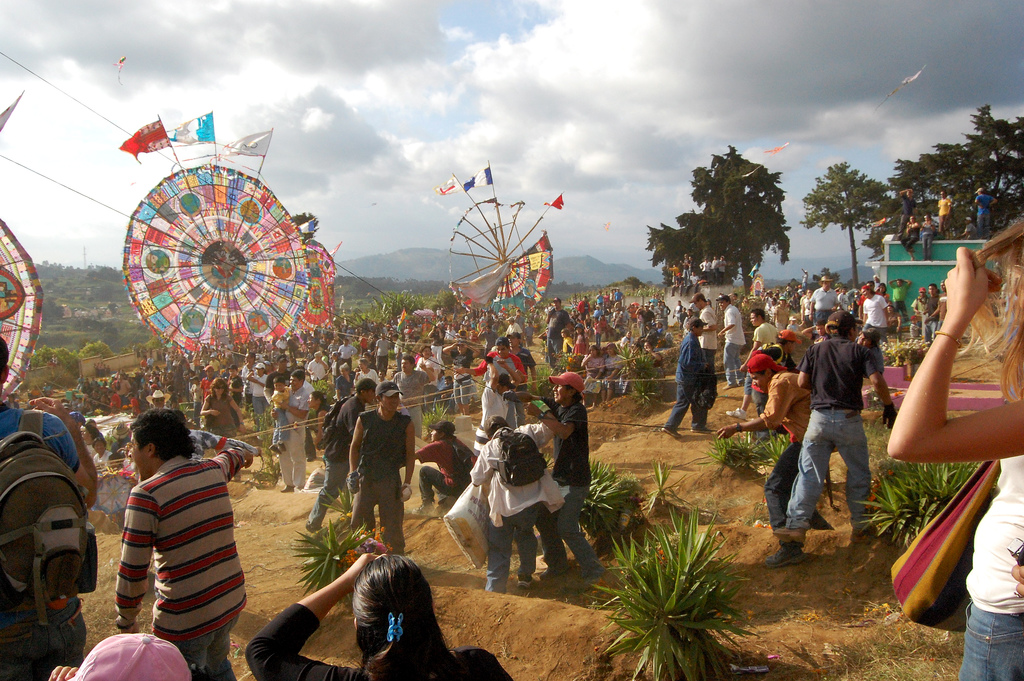
Christians in different nations celebrate All Saints’ Day each year. On this day, people in nations like Spain, Portugal, and Mexico leave gifts for the dead. Flowers are often laid on the graves of nations such as Belgium, Hungary, and Italy.
It is traditional to place lights atop graves while paying respects in various European countries including Austria, Croatia, Poland, and Romania. People visit the graves of ancestors and other loved ones. Furthermore, they are also cleaned or repaired as part of the ritual. Candles are lit, and flowers are laid at the graves.
Church ceremonies honoring the saints are performed in France on November 1, but when night falls, attention shifts to the deceased. Throughout the world, people go to cemeteries to tend to and adorn family graves. The day after All Saints Day, November 2, is All Souls Day, a day devoted to praying for the souls of the departed who have not yet attained glorification.

Background of All Saints Day
All Saints’ Day originated in the fourth century when Greek Christians celebrated the saints and martyrs on the first Sunday following Pentecost (about the end of May or the beginning of June).
Other accounts claim that a holiday honoring “All Martyrs” was first observed in the year 270 CE, albeit neither the month nor the exact day of the year is known. In 835 CE, Pope Gregory IV officially established All Saints’ Day as a public holiday. The date of November 1 was reportedly selected in an effort to compete with the pagan Festival of the Dead (also called Samhain or the feast of Saman, lord of death).
All Saints’ Day and All Souls’ Day are two separate Christian holidays. The later, All Souls’ Day, originated in the Cluny abbey in 993 CE and soon gained popularity among believers.
All Saints Day’s Traditions
All Saints’ Day celebrates the departed in a manner similar to that of Halloween. People go to brightly painted graves to pay their respects to loved ones who have passed on.
The Fiambre, Carreta de Caballos, and Festival de Barriletes Gigantes are three unique ways in which the deceased are honored in this culture. Families begin arriving at the cemetery at 4 am to begin preparing for the day’s festivities by bringing flowers, candles, water, and music.
On this day, a meal known as Fiambre is traditionally served. Spanish colonial-era meats, cheeses, olives, and seafood are all brought together in this meal. They share it with loved ones and take some to the cemetery to honor the departed.

Recommended Reading: Best Breweries in Mackinaw City For Beer Lovers
Other Festivities
The festivities would not be complete without the flowers and the feast. Bands often perform music at funerals to comfort the departed. These two days are the most significant celebrations for Catholics in Latin America.
The festivities often start a few days before November 1 and continue for at least two weeks (and often longer) thereafter. Different types of processions and dances are performed in the public squares and streets of Guatemala. Making beautiful and tasty decorations and food is a vital part of every celebration.
As part of the festivities, musicians perform traditional Marimba music and participants dance The Bull and The Deer. In many places, particularly in the highlands, everyone wears traditional Mayan garb.
Festival De Los Barriletes
At the Festival De Los Barriletes, enormous kites are flown in celebration. The graveyard is packed with kites on the day of the celebration. This is due to the widespread belief among Guatemalans that flying kites bring friendly ghosts closer to Earth.
The kites are made of colorful paper and may take up to a hundred different groups of people to complete. The town of Todos Santos has a drunk horse race since, on this day alone, alcoholic beverages are permitted. Todos Santos Cuchumatan, a town in the Huehuetenango mountains of Guatemala, hosts the annual celebration on November 1.

There will not be any racing during this event, since it is more of a traditional celebration. The key elements are drinking heavily and dressing in period costumes. Riders often tote chickens and pedestrians accessorize with bright scarves.
Kids can make wax balls out of melted candles that have been placed at gravesites. The statement that everything returns to its origin is represented by the spheres since even the living will one day become dust.
Candles representing the number of loved ones who have passed away are sometimes lit at the front entrance. The lights are said to help the departed find their way to the next world.
Travel Advisory: How to travel with Insulin: Tips and Tricks
All Saints’ Day Rituals
Many ceremonies take place on this day. Incense and animal sacrifice are two examples of rituals used by certain groups. Another common ritual involves offering smoke and wine to a polytheistic saint. Maximon, also known as Saint San Simon, is worshiped in this ceremony with the expectation that he would bestow blessings in exchange for the offerings made to his altar.
One such custom associated with holidays is dancing. Most people would consider it disrespectful to tread on a grave.
In Guatemala, however, it is part of the ceremony to dance and celebrate atop the graves. Family and friends celebrate the life of the dead with drinks and music.
Like their Mexican counterparts, Catholics in Guatemala spend All Saints’ Day (El Da de los Todos Santos) in cemeteries with food and other tributes prepared in honor of the departed.
- Indigenous Maya people decorate the graves with pine needles, marigolds (known as flor de muerto), candles, booze, and incense (known as copal pom).
- The cemetery is packed with mourners playing marimbas and dancing in honor of their departed loved ones by early afternoon.
- The ritual of parading three holy skulls (known locally as las Santas calaveras) around the streets of San Jose Petén in northern Guatemala is deeply rooted in local culture.
Moreover, people seek out what are believed to be the skulls of local Mayan rulers or priests in exchange for health, a successful marriage, or abundant harvests. By making a request, you are agreeing to host the skulls at your home for the next three years.
Mausoleums in Vivid Colors
One of the most important aspects of All Saints’ Day in Guatemala is the decorating of colorful mausoleums. Natural stone is often used in headstones and cemeteries in different nations. On November 1st, people in Guatemala painted elaborate artwork on the tombstones of the deceased.
Particularly in preparation for the festival, the Chichicastenango cemetery is given a fresh coat of paint every year. In their culture, each hue represents something distinct. Many cultures associate the color yellow with the sun’s vitality, white with chastity, turquoise with safety, and other colors with the afterlife.
Guatemalans think that by painting these hues in graves, they would produce good fortune for the living and have excellent relationships between the living and the dead.
Editor’s Pick: How to carry your Suit on a Plane: No Wrinkles and Shrinking
All Saints Day Guatemala Fest: What to Wear?
When attending the All Saints Day Festival in Guatemala, it is recommended to dress respectfully and comfortably. Here are some suggestions for what to wear:

- Modest attire: As All Saints Day is a religious and cultural event, it is important to dress modestly and respectfully. Avoid wearing revealing or provocative clothing. Opt for clothing that covers your shoulders and knees.
- Comfortable shoes: The festival often involves visiting cemeteries, walking around, and participating in various activities. Wear comfortable shoes or sandals that you can walk in for extended periods without discomfort.
- Light and breathable clothing: Guatemala’s climate is generally warm, so it is advisable to wear light and breathable clothing to stay comfortable throughout the festivities. Choose fabrics such as cotton or linen that allow air circulation.
- Sun protection: Don’t forget to protect yourself from the sun. Wear a wide-brimmed hat or cap to shield your face from direct sunlight. Additionally, apply sunscreen to exposed skin and carry sunglasses for eye protection.
- Traditional attire (optional): If you want to embrace the local culture and immerse yourself fully in the festival, you may consider wearing traditional Guatemalan clothing. These garments often feature vibrant colors and intricate designs, showcasing the country’s rich textile heritage. However, keep in mind that traditional attire is not mandatory, and you can still enjoy the festival in regular clothing.
Conclusion
All Saints’ Day in Guatemala is a day of festivities and celebrations. Most people were either having picnics or simply relaxing outside. A day of honoring the deceased had blended with joy, eating, a kite spectacular, and, in typical Guatemalan fashion, a riot of color, making for a delightfully unusual day. For more such adventures, read Must check out these things to do in Hilton Head SC and Carlsmith Beach Park (Hilo).
All Saints Day Guatemala Feast - FAQs
All Saints Day, locally known as Día de Todos los Santos, holds great cultural and religious importance in Guatemala. This day is dedicated to honoring and remembering deceased loved ones, where families gather to visit cemeteries, clean and decorate graves, and offer prayers and offerings to their departed relatives.
The All Saints Day Festival is observed on November 1st every year in Guatemala. It’s a national holiday, and many people take the opportunity to spend time with their families, participate in religious ceremonies, and engage in traditional customs associated with the occasion.
The celebrations of All Saints Day in Guatemala are marked by various customs and traditions. Families often create colorful altars called “kites” or “barriletes” adorned with flowers, fruits, and the favorite foods and beverages of their deceased loved ones. These altars are displayed in homes or at gravesites.
Sumpango Sacatepéquez showcases enormous handmade kites, some reaching up to 40 feet in diameter, which are flown to symbolize the connection between the living and the dead. The festival also includes traditional music, dances, and culinary delights.
Absolutely! Visitors are welcome to witness and participate in the All Saints Day celebrations in Guatemala. It is a vibrant and inclusive festival that allows people from different cultures and backgrounds to appreciate and engage in the rich traditions of the country.
![What To Wear To a Drag Show? [HOTTEST Outfit Ideas]](https://hopdes.com/wp-content/uploads/2024/01/What-to-wear-to-a-Drag-Show-390x220.jpg)



![What to Wear to an Outdoor Concert? [Cute Outfit Ideas]](https://hopdes.com/wp-content/uploads/2023/11/What-to-Wear-to-an-Outdoor-Concert-Cute-Outfit-Ideas-390x220.jpg)

